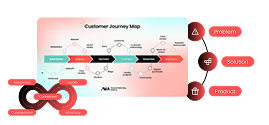In a world where product complexity collides with buyer expectations, yesterday's marketing playbook is obsolete.
Technical product marketers now face a critical question: How do we measure success in this new landscape?
Is it still about lead volume? Revenue attribution? Or something more nuanced?
Drawing from experience, I'll unveil the metrics that truly signal victory and identify the key stakeholders who can help move these needles.
5 key metrics to consider with technical product marketing
When coming to measuring success within modern products (B2B/SaaS and the like), a few metrics come to mind:
- Revenue and pipeline contribution
- Product and features adoption
- Content and messaging effectiveness
- Sales and Go-to-Market (GTM) enablement impact
- Brand and market positioning
Let’s explore each of the above metrics and understand what they encapsulate and why they are so important.
Revenue and pipeline contribution
Measuring the bottom line within the business is obviously one of the most important metrics. Being able to attribute increased revenue (upsell, new business) to product marketing activities is GOLD!
Being able to link marketing campaigns, content pieces (thought leadership, gated lead-gen pieces, paid content, etc.), as well as field enablement activities to revenue is a solid sign of success.
To be able to properly measure these methods, the product marketing and marketing teams ought to have good analytics in place to report on a daily/weekly/monthly basis how the above activities perform.
Equally important, the departments must fine-tune, correct these programs, retire non-performing campaigns or content pieces, and only focus on the ones that move the needle.
In addition to the increased revenue metric mentioned above, investing in new pipeline generation and being able to measure the contribution of the above-mentioned activities to new pipelines is very important.
Lastly, measuring deal acceleration and shortening sales cycles through product marketing activities is a great metric.
Such metrics can be tied to external and customer-facing assets like new case studies (G2, Gartner peer insights, video case studies) or internal enablement materials like polished battle cards that articulate the differentiation your product has over your competitors.
To summarize this category and metrics, measuring the business impact is a core piece of any successful product marketing journey.
And within such a demanding marketplace and fierce competition, emphasizing how you differentiate, and how you serve your target persona with intelligent and value-based content makes the difference between success and failure.
Product and feature adoption
For any product marketer and product manager as well as the business unit, seeing new features and capabilities adopted by your existing and new customers is a key objective and a measure of success.
To be able to measure such adoption systems and built-in product analytics and dashboards must be in place.
From a metrics perspective, you would want to be able to effectively and reliably measure the following:
This category and metrics are fully dedicated to product and technology value to the customer that is translated into renewals, expansion, usage rates, etc.
To contribute to these metrics from a PMM perspective, there must be a set of campaigns, customer success engagements, communication with the executive buyers within your customer base, and fresh and appealing content creation that drives both usage and awareness.
Content and messaging effectiveness
As a published author, I specifically love this category since I believe that content marketing has a tremendous impact on the sales cycle, brand awareness, and reputation – as well as core differentiation in the marketplace.
The power of content and messaging, when done right, often goes beyond just increased revenue and business success but also grants the company prestigious market awards.
From measurement perspectives, being able to quantify the success of your content and messaging spans around the following metrics:
Metrics such as the number of views, downloads, and time spent on key assets (whitepapers, solution briefs, blog posts) easily imply the value you’re giving your readers across the content that you produce. Measure, learn, and improve from these metrics.
Content and messaging are a valuable pillar of any successful PMM strategy. Invest the time and budget in making the content that you deliver to your end users fresh, appealing, and such that crystalizes the unique value that you can bring to the users.
Focus on problem-solving as well as make your content match the persona that is reading it.
Sales and GTM enablement impact
As PMM you are not the one that engages with your prospects and sells the product, hence, you must ensure that the sales and GTM function within your organization is fully enabled and equipped with the right tools, content, competitive intelligence, and more to be successful.
To be able to measure that you have done your “JOB” right within this category, aim to measure the following:
Product marketing engages with so many internal business units – from product management through marketing, R&D, customer success, support, and leaders.
However, at the end of the day what matters the most is how your GTM team operates and how effective it is in increasing revenue. To do so requires proper enablement and sharp tools to make their lives easier.
Brand and market positioning
As we mentioned in the above four categories, many metrics can prove success in your GTM and product marketing activities, but in addition, there is also the market perception and references that you can obtain upon successful launches and activities.
Consider measuring the above metrics to learn whether your “voice” is heard by key analysts and research firms, award providers, and more.
This category is the least business-oriented or sales revenue-oriented and it is more around the effectiveness of PMM activities in driving market awareness, brand recognition, award-winning, and customer satisfaction.
In many cases, these KPIs directly contribute to more buying by decision-makers who read these reports and listen to the feedback that comes from analysts and other customers who realize the value of your product.
Bottom line
In the above article, I have summarized many metrics across categories that can help measure successful technical PMM operations.
It is hard to measure all of the above at once and per each product launch, therefore it is important to build these gradually and measure them as needed and per release types – minor, major, etc.
The important thing is to have your north star and metrics in place, measure and improve your activities based on learnings and feedback from your internal audience as well as your customers. Focus of course on the key metrics from the above that matter the most to you.


















 Follow us on LinkedIn
Follow us on LinkedIn



.svg?v=85af970283)